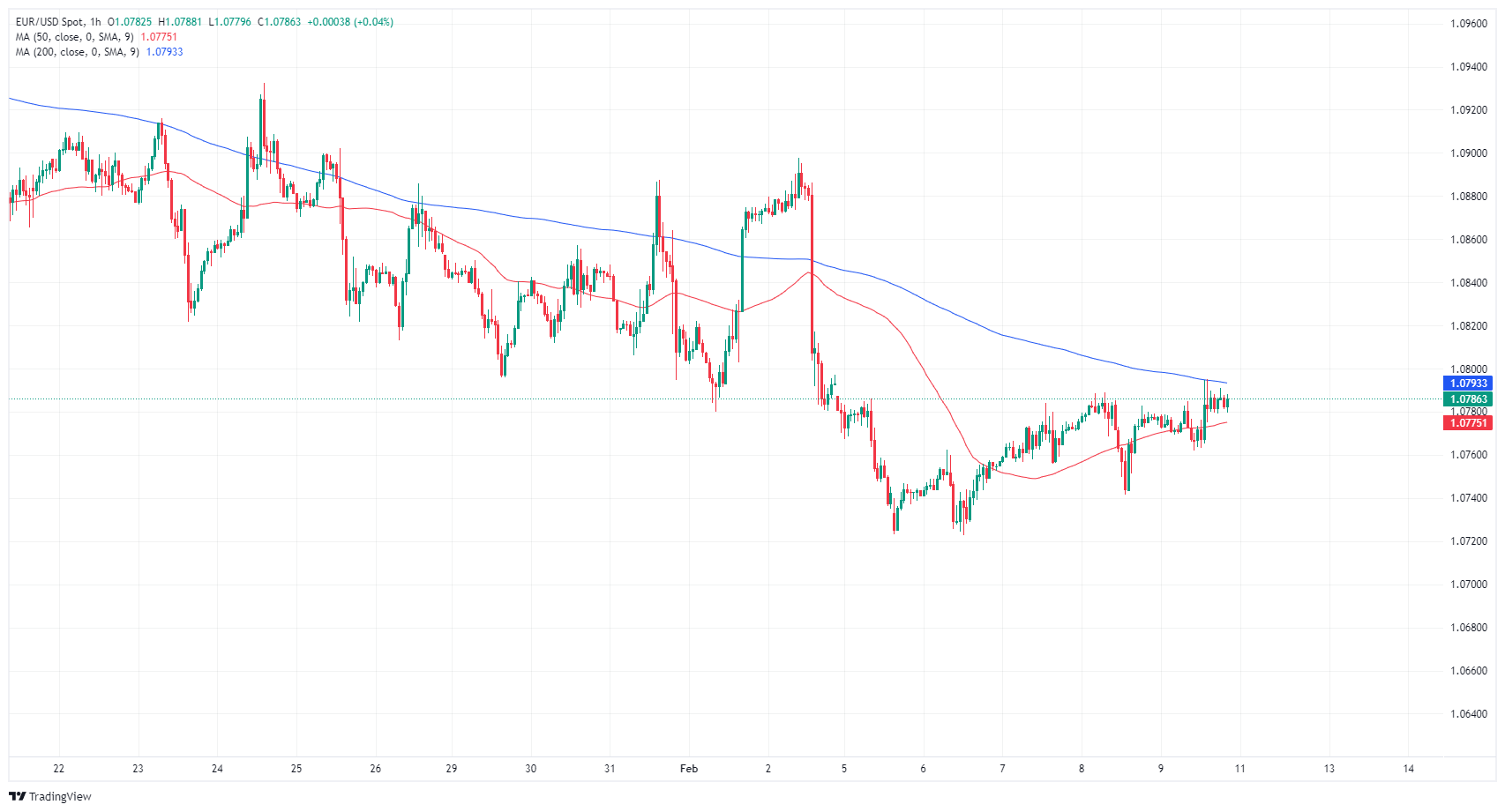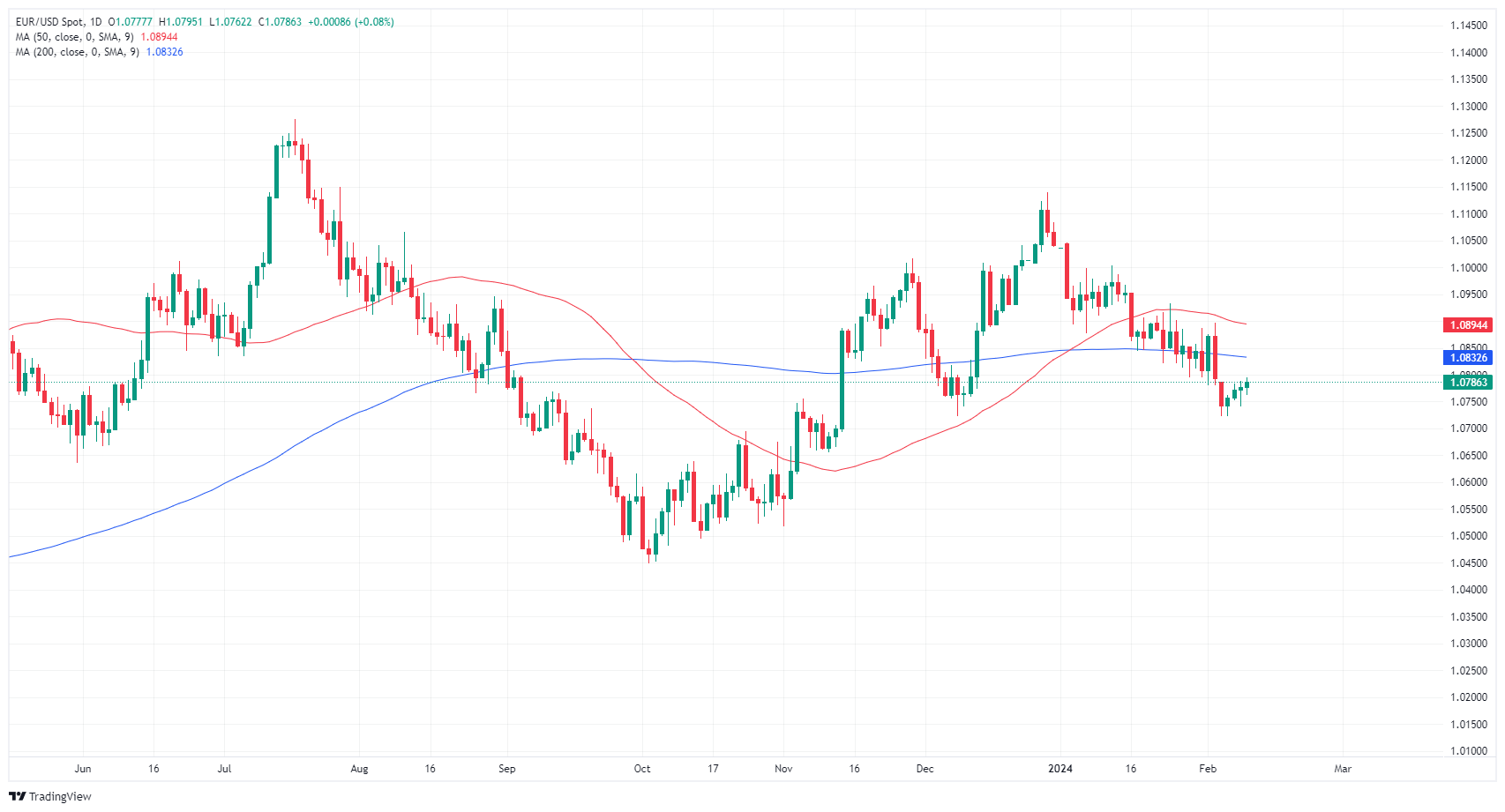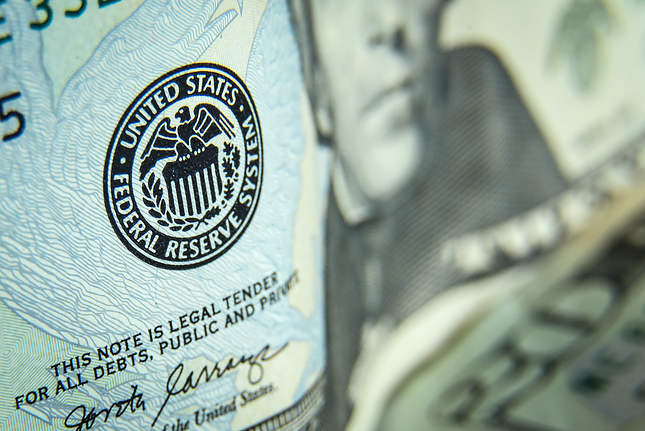- EUR/USD found some room higher but still lacks upside momentum.
- Final German HICP and CPI inflation brought no surprises.
- US CPI inflation, EU GDP figures slated for next week.
The EUR/USD found some room on the high side on Friday, continuing a near-term recovery. However, the pair remains firmly planted on the low side of technical barriers and remains pinned below the 1.0800 price handle.
German inflation figures brought nothing new to the table, confirming initial flash prints, and an adjustment by the US Bureau of Labor Statistics (BLS) made anticipated changes to how seasonal adjustment is calculated in US Consumer Price Index (CPI) figures. Markets jostled after the BLS adjustment, but US inflation figures saw little change, keeping markets on-balance for Friday.
Daily digest market movers: EUR/USD continues slow grind higher as technical ceiling weighs
- Germany’s final Harmonized Index of Consumer Price (HICP) showed no changes from preliminary prints, with the annualized German inflation rate through January holding at 3.1%.
- The US BLS made changes to how seasonal adjustment works for US CPI numbers, with a slight rise in annualized inflation getting offset by a near-term decline after calculations got adjusted.
- US December monthly CPI revised to 0.2% from 0.3%
- Next week brings a fresh print of US CPI inflation, with the YoY CPI through January expected to tick down from 3.4% to 3.0%.
- US CPI inflation slated for Tuesday, European Gross Domestic Product (GDP) figures due Wednesday.
- Pan-European GDP growth is expected to remain pinned in low territory.
- YoY quarterly EU GDP is forecast to print at 0.1%, in-line with the previous annualized quarterly print.
Euro price today
The table below shows the percentage change of Euro (EUR) against listed major currencies today. Euro was the strongest against the Swiss Franc.
| USD | EUR | GBP | CAD | AUD | JPY | NZD | CHF | |
| USD | -0.09% | -0.09% | 0.00% | -0.43% | 0.00% | -0.75% | 0.13% | |
| EUR | 0.09% | 0.00% | 0.09% | -0.35% | 0.08% | -0.66% | 0.22% | |
| GBP | 0.09% | -0.01% | 0.10% | -0.34% | 0.09% | -0.66% | 0.22% | |
| CAD | -0.01% | -0.09% | -0.09% | -0.42% | -0.01% | -0.76% | 0.12% | |
| AUD | 0.43% | 0.32% | 0.32% | 0.41% | 0.42% | -0.32% | 0.56% | |
| JPY | 0.01% | -0.08% | -0.07% | 0.00% | -0.44% | -0.72% | 0.15% | |
| NZD | 0.75% | 0.66% | 0.66% | 0.75% | 0.32% | 0.75% | 0.88% | |
| CHF | -0.14% | -0.23% | -0.22% | -0.13% | -0.56% | -0.13% | -0.89% |
The heat map shows percentage changes of major currencies against each other. The base currency is picked from the left column, while the quote currency is picked from the top row. For example, if you pick the Euro from the left column and move along the horizontal line to the Japanese Yen, the percentage change displayed in the box will represent EUR (base)/JPY (quote).
Technical analysis: EUR/USD struggles to grow legs beneath technical recovery
The EUR/USD remains pinned on the south side of the 200-hour Simple Moving Average (SMA) just beneath 1.0800. Although the pair continues to recover into the upside from the early week’s bottom near 1.0725, topside momentum remains capped, with longer-term technical patterns remaining decidedly bearish.
Despite posting three straight days of gains and on pace for a fourth, the EUR/USD remains on the bearish side of the 200-day SMA at 1.0833. The pair is still down over 3% from late December’s peak of 1.1140, and Euro bidders are struggling to lift the Euro off the floor of a nearly 4% decline into January’s bottom bids of 1.0722.
EUR/USD hourly chart
EUR/USD daily chart
Risk sentiment FAQs
What do the terms"risk-on" and "risk-off" mean when referring to sentiment in financial markets?
In the world of financial jargon the two widely used terms “risk-on” and “risk off'' refer to the level of risk that investors are willing to stomach during the period referenced. In a “risk-on” market, investors are optimistic about the future and more willing to buy risky assets. In a “risk-off” market investors start to ‘play it safe’ because they are worried about the future, and therefore buy less risky assets that are more certain of bringing a return, even if it is relatively modest.
What are the key assets to track to understand risk sentiment dynamics?
Typically, during periods of “risk-on”, stock markets will rise, most commodities – except Gold – will also gain in value, since they benefit from a positive growth outlook. The currencies of nations that are heavy commodity exporters strengthen because of increased demand, and Cryptocurrencies rise. In a “risk-off” market, Bonds go up – especially major government Bonds – Gold shines, and safe-haven currencies such as the Japanese Yen, Swiss Franc and US Dollar all benefit.
Which currencies strengthen when sentiment is "risk-on"?
The Australian Dollar (AUD), the Canadian Dollar (CAD), the New Zealand Dollar (NZD) and minor FX like the Ruble (RUB) and the South African Rand (ZAR), all tend to rise in markets that are “risk-on”. This is because the economies of these currencies are heavily reliant on commodity exports for growth, and commodities tend to rise in price during risk-on periods. This is because investors foresee greater demand for raw materials in the future due to heightened economic activity.
Which currencies strengthen when sentiment is "risk-off"?
The major currencies that tend to rise during periods of “risk-off” are the US Dollar (USD), the Japanese Yen (JPY) and the Swiss Franc (CHF). The US Dollar, because it is the world’s reserve currency, and because in times of crisis investors buy US government debt, which is seen as safe because the largest economy in the world is unlikely to default. The Yen, from increased demand for Japanese government bonds, because a high proportion are held by domestic investors who are unlikely to dump them – even in a crisis. The Swiss Franc, because strict Swiss banking laws offer investors enhanced capital protection.
Information on these pages contains forward-looking statements that involve risks and uncertainties. Markets and instruments profiled on this page are for informational purposes only and should not in any way come across as a recommendation to buy or sell in these assets. You should do your own thorough research before making any investment decisions. FXStreet does not in any way guarantee that this information is free from mistakes, errors, or material misstatements. It also does not guarantee that this information is of a timely nature. Investing in Open Markets involves a great deal of risk, including the loss of all or a portion of your investment, as well as emotional distress. All risks, losses and costs associated with investing, including total loss of principal, are your responsibility. The views and opinions expressed in this article are those of the authors and do not necessarily reflect the official policy or position of FXStreet nor its advertisers. The author will not be held responsible for information that is found at the end of links posted on this page.
If not otherwise explicitly mentioned in the body of the article, at the time of writing, the author has no position in any stock mentioned in this article and no business relationship with any company mentioned. The author has not received compensation for writing this article, other than from FXStreet.
FXStreet and the author do not provide personalized recommendations. The author makes no representations as to the accuracy, completeness, or suitability of this information. FXStreet and the author will not be liable for any errors, omissions or any losses, injuries or damages arising from this information and its display or use. Errors and omissions excepted.
The author and FXStreet are not registered investment advisors and nothing in this article is intended to be investment advice.
Recommended content
Editors’ Picks

AUD/USD appreciates as US Dollar remains subdued after a softer inflation report
The Australian Dollar steadies following two days of gains on Monday as the US Dollar remains subdued following the Personal Consumption Expenditures Price Index data from the United States released on Friday.

USD/JPY consolidates around 156.50 area; bullish bias remains
USD/JPY holds steady around the mid-156.00s at the start of a new week and for now, seems to have stalled a modest pullback from the 158.00 neighborhood, or over a five-month top touched on Friday. Doubts over when the BoJ could hike rates again and a positive risk tone undermine the safe-haven JPY.

Gold downside bias remains intact while below $2,645
Gold price is looking to extend its recovery from monthly lows into a third day on Monday as buyers hold their grip above the $2,600 mark. However, the further upside appears elusive amid a broad US Dollar bounce and a pause in the decline of US Treasury bond yields.

Week ahead: No festive cheer for the markets after hawkish Fed
US and Japanese data in focus as markets wind down for Christmas. Gold and stocks bruised by Fed, but can the US dollar extend its gains? Risk of volatility amid thin trading and Treasury auctions.

Bank of England stays on hold, but a dovish front is building
Bank of England rates were maintained at 4.75% today, in line with expectations. However, the 6-3 vote split sent a moderately dovish signal to markets, prompting some dovish repricing and a weaker pound. We remain more dovish than market pricing for 2025.

Best Forex Brokers with Low Spreads
VERIFIED Low spreads are crucial for reducing trading costs. Explore top Forex brokers offering competitive spreads and high leverage. Compare options for EUR/USD, GBP/USD, USD/JPY, and Gold.